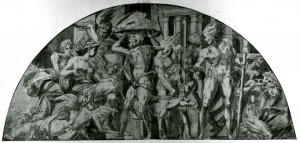Frankfurt am Main, Städelsches Kunstinstitut und Städtische Galerie, inv. no. 4291.
Pen and brown ink, gray and gray-brown wash, 22.8 x 48.5; indentations made with a stylus.
PROVENANCE: Acquired by the museum before 1862.
LITERATURE:
Dimier, 1900, 482, as a copy of Fantuzzi’s print after Rosso.
Béguin, RdA, 1969, 105, mentioned that there are several drawings of this composition, in particular the one in Frankfurt, the composition of which is probably Rosso’s.
The composition of this drawing is the same as that of a reversed etching by Fantuzzi (Fig.RE.17) that Bartsch and Herbet thought was after Primaticcio, although the latter stated that the design has been attributed to Rosso. Zerner thought it was after Rosso but that Fantuzzi had transformed its style in a manner resembling Primaticcio’s. The museum attributes the drawing to Primaticcio. Béguin also thought the composition was Rosso’s and the drawing a copy after one by him.
The drawing has a few figures that recall several by Rosso. The central nude man holding the dogs resembles the figure (St. Joseph?) rushing forward in the center of Rosso’s Allegory on the Birth of Christ (Fig.D.72), also etched by Fantuzzi (Fig.E.81). Atalanta is somewhat similar to the figure of Fortune in the stucco roundel of the East Wall of the Gallery of Francis I, the composition of which is found in another etching by Fantuzzi (Fig.E.68). At the lower left the winged figure appears as a more adult and reversed version of the putto in the foreground of Rosso’s Death of Adonis that Fantuzzi etched (Fig.E.76). The figure of Envy at the lower right is similar to the same personification in Rosso’s Pandora and Her Box (Fig.D.67a), and in Fantuzzi’s print of it (Fig.E.79a), although Rosso’s figure looks more wretched. It should also be noted that the simple round band held above Atalanta’s head is the kind of crown that would seem to have appeared in Rosso’s drawings – see his Contest of Athena and Poseidon as engraved by Boyvin (Fig.E.13) – but that would be changed into a crown of leaves in the finished composition – as in Fantuzzi’s etching of the Athena and Poseidon composition (Fig.E.78). Fantuzzi’s etching of the Meleager composition shows the simple band as in the Frankfurt drawing.
Although the draughtsmanship of the Frankfurt drawing resembles that of some pen and ink and wash drawings by Rosso, the clumsy handling of the drawing could not be Rosso’s. Other stylistic relationships to Rosso’s art would seem also to indicate that he is the author of the composition. But the general ease or grace of the postures of the figures and of their arrangement in space is not characteristic of Rosso. The scene lacks the tension of such comparable crowded and dramatic compositions by him as the Death of Adonis and the Allegory on the Birth of Christ. Furthermore, what might be considered bizarre about the drawing is mitigated by a degree of realism and even idealism that does not point to Rosso. I believe the composition is by Primaticcio in a particularly Rossoesque phase, in the early 1540s most likely. It can be compared with several drawings by him from this decade.1 The Frankfurt drawing would be a copy of a drawing by Primaticcio. However, it is possible that the original drawing was done in the 1530s before Rosso died, although the evidence for this is not now available. In either case, the original drawing would have been done when Primaticcio was compelled to take on aspects of Rosso’s more dramatic expression. The Frankfurt drawing, which shows stylus marks, could have been used as the model for Fantuzzi’s etching, which Zerner dated 1544-1545.
1 See EdF, 1972, 140, Fig., 141, no. 150, Forge of Vulcan (Fig.Primaticcio, Forge), 144, Figs., 145, 147, nos. 155 (Fig.Paris Wounded), and 156, (Fig.Masquerade at Persepolis) and 146, Fig., 148, no. 159 (Fig.Primaticcio, Virgin, Queen of the Angels).

